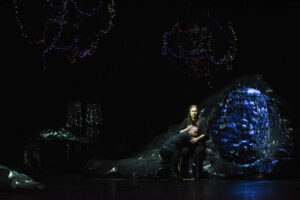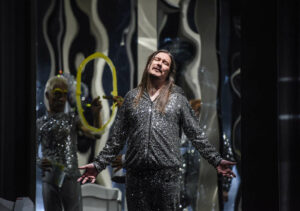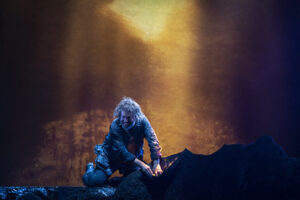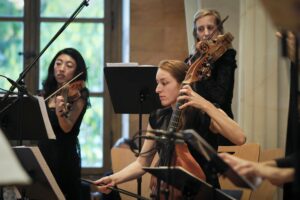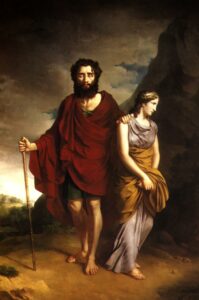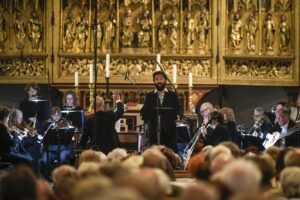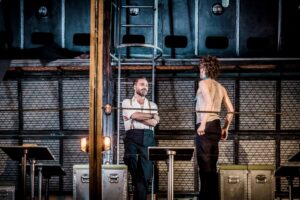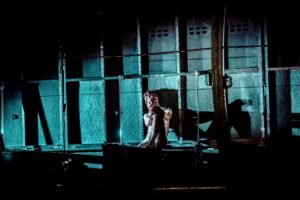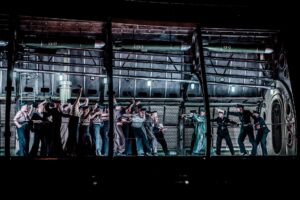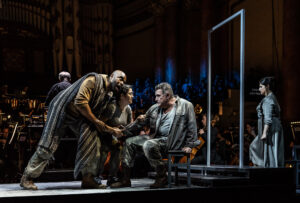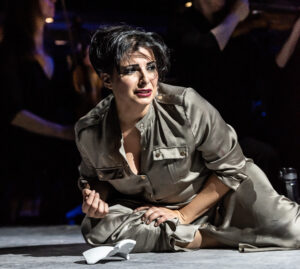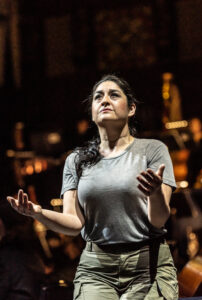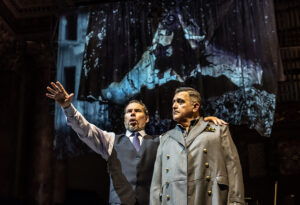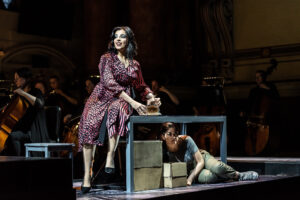A Roundabout Journey to the Beginning of the World
This is yet another June that I am spending with Wagner’s music: more and more intensively from year to year, since the first Tristan in Longborough (put on for the 150th anniversary of the world première), because I have been deliberately following the singers who have been making their entrée into the world of the master of Bayreuth under the watchful care of Anthony Negus. This time, as a prelude to the new staging of Der Ring des Nibelungen under his baton, I decided to head to Konzert Theater Bern for a Tristan featuring Lee Bisset, a phenomenal Isolde in the 2017 revival of the Longborough Festival Opera’s production, as well as Swedish tenor Daniel Frank, whom I was not able to see in the last year’s Götterdämmerung in Karlsruhe – which I regretted enormously at the time, for he had sounded very promising in recordings. The Bern opera house, furthermore, has a beautiful Wagnerian tradition: the Neo-Baroque building designed by René von Wurstemberger was inaugurated in 1903 with a presentation of Tannhäuser; and the Swiss première of Tristan took place in March 1889 at the Hôtel de Musique, the theatre’s previous headquarters which were demolished at the beginning of the 20th century.
I traveled to Switzerland full of the highest hopes: the stage-directing concept was the responsibility of Ludger Engels, a thoroughly-educated German musician who took a turn in the direction of theatre at the instigation of distinguished conductor and Bach-Collegium Stuttgart founder Helmuth Rilling. Since the mid-1990s, Engels has directed over 30 opera productions, including a Minimalist, relatively well-received staging of Tristan und Isolde for Theater Aachen (2012). If I had read the reviews of that production more carefully, a red light would have gone on in my head. For even critics immune to the extravagances of German Regieoper pointed out the lack of any relationships between the title characters, accusing the director of treating Tristan too literally as an idea drama. In Bern, Engels went all the way and transfigured Wagner’s masterpiece into a multileveled theatre-in-a-theatre, referring to the work of Berlin performance artist Jonathan Meese. Perhaps readers remember that in 2014, Meese was supposed to prepare a new staging of Parsifal in Bayreuth. The Festival management finally dissolved their contract with him, officially citing the endeavour’s excessively high cost. Behind the scenes, it was whispered that the problem was rather the artist’s predilection for the Nazi ‘Heil Hitler’ gesture, for the use of which – in his performance art work entitled Größenwahn in der Kunstwelt, presented at the documenta exhibition – Meese faced charges at the Regional Court in Kassel. He won the case and did not abandon his controversial practices. Frankly, his artistic performances border on chutzpah: a certain critic even christened him the a Borat of contemporary art.
Tristan und Isolde at the Konzert Theater Bern. Daniel Frank (Tristan) and Robin Adams (Kurwenal). Photo: Christian Kleiner
This did not, however, prevent Engels from characterizing Tristan as Jonathan Meese, supplying him with three Isoldes (one singing, supposedly a metaphor of Mathilde Wesendonck; and two silent: Wagner’s first wife Minna, that is, his past love; and his future companion Cosima, whom he for unknown reasons posed as a cross between Lady Gaga and Klaus Nomi); and trashing the stage with oodles of props which, to the initiated, brought to mind the art of the German scandalmonger, but reminded probably no one of Wagner’s drama (stage design: Volker Thiele; costumes: Heide Kastler; lights: Bernhard Bieri). And as if that weren’t enough, he played out each of the three acts in a completely different stylistic language, without drawing them together through any kind of narrative link, and then made the singer playing the roles of the Shepherd and the Young Sailor (Andries Cloete) ‘stage direct’ the whole thing. I shall not undertake any thorough exegesis of Engels’ concept – I shall only report that in the final accounting, no one died (but neither did anyone connect with anyone); and in the final scene, the director did not fail to remind us of Meese’s declaration that ‘Kunst ist totalste Freiheit’. Judging from the uproarious laughter in Act III when Kurwenal asks Tristan, ‘Bist du nun tot? Lebst du noch?’, the audience noticed certain divergences between the libretto and the stage director’s vision.
Unfortunately, the onstage mess affected the quality of the singing. Lee Bisset came out considerably beneath her abilities – while the acting was superb, she sang in a tired voice with excessive vibrato and insecure intonation. Daniel Frank – blessed with a tenor of beautiful timbre and a high degree of musicality – began to lose power already in the middle of Act II, and was not able to build the tension in Tristan’s long death scene. The velvety-voiced Claude Eichenberger (Brangäne), though awkward from an acting standpoint, made a fine impression. Robin Adams shaped the character of Kurwenal solidly, but at times he clearly lost control over the volume of his powerful baritone. The unexpected hero of the evening turned out to be the Berner Symphonieorchester – playing with slightly reduced forces under the baton of their director Kevin John Edusei at quite slow tempi and with a clear, ‘Modernist’ sound. This was a Wagner decidedly closer to the aesthetics of Boulez than – let us say – Thielemann, splendidly adapted to the acoustics of the hall and sufficiently intriguing to draw attention away from the indubitable weaknesses of Ludger Engels’ staging.
I traveled to England with the steadfast conviction that things could only get better. Confident about the musical side of the first part of the Ring in Longborough, I was a bit nervous about the staging concept of Amy Lane – a talented stage director, though not yet very experienced (to date, she has honed her craft above all as an assistant; she has also worked on revivals of, among other items, Kaspar Holten’s take on King Roger for the Sydney Opera House). My fears turned out to be unfounded, though it would be difficult to call the new vision of Das Rheingold innovative. Lane alluded loosely to the legendary Ring staging of Patrice Chéreau – an image of Europe in Industrial Revolution times, a soulless world controlled by lust for profit, eaten away by the cancer of corruption and exploitation. Chéreau ‘bourgeois’ Ring had been, however, extraordinarily clear from a visual standpoint, while Lane did not resist the temptation to complement the economical stage design (Rhiannon Newman Brown) with ubiquitous and sometimes overly literal projections. Some of Tim Baxter’s ideas, however, spoke to the imagination – above all, the Modernist vision of Valhalla, looming in the distance like the silhouette of an unfinished factory.
Das Rheingold at the LFO. Darren Jeffery (Wotan). Photo: Matthew Williams-Ellis
On the other hand, Amy Lane guided the singers in a masterful manner, subtly highlighting the character traits of the protagonists and network of interdependencies in which they are entangled. Her tragic take on Alberich shed new light on the inevitable fall of Wotan – he stumbled into the embrace of evil gradually, motivated at first by humiliation, then by anger and cruelty, finally by overwhelming despair. The death of Fasolt was predictable already at the moment when, nestled in the giant’s embrace, Freia for a split-second returned his caress – thereby giving evidence of the feelings arising between the two of them, which could foil the plans of the gold-hungry Fafner. Loge turned out to be a quintessentially Mephistophelian character: a connoisseur of the nature of gods, dwarves and giants, but at the same time, an enemy of all inhabitants of the mythical world; an ironic mocker who, beneath the mask of a smile, concealed deep contempt for the representatives of all creation. The perverse demigod, who plays a key role in the narrative of Das Rheingold, would have been even more convincing had Lane brought him closer to Goethe’s prototype, instead of giving him traits of the devil from late Romantic takes on Gounod’s opera. It would also have been worthwhile to polish up the differences of proportion between the characters: a Mime who clearly towers over other protagonists disturbs the credibility of the narrative. Some of the fault for this lies with the costume designer (Emma Ryott) – fortunately, much time remains until the closing of the Ring, so there will be opportunity yet to correct minor flaws in the staging.
It is difficult to determine who among the cast deserved the most applause – the surprising, indeed Expressionist Alberich of Mark Stone, blessed with a perfectly-placed and richly-shaded baritone; or the terrifying Loge of Marc Le Brocq, with each phrase chiseled like a laser engraving on marble, luminous and intonationally secure. Darren Jeffery built a surprisingly ‘human’ character of Wotan – with a voice full of melancholy, sometimes trembling in pain, bringing to mind associations with the most subtle performances of the German Lied repertoire. His soft bass-baritone found an ideal counterweight in the sonorous and rounded soprano of Madeleine Shaw (Fricka), which superbly conveyed the quandaries of the father of the gods’ partner entangled in ‘male’ intrigue. Blessed with a sensuous, almost girlish soprano, Marie Arnet portrayed a very convincing Freia; Adrian Dwyer, who has a clear and piercing tenor at his disposal, sang out Mime’s torment in a shocking manner. Out of the two giants, the more memorable for me was the moving Fasolt (Pauls Putnins). It is a bit regretful that the otherwise quite good Froh (Elliot Goldie) ran out of power just before the finale: in the ecstatic phrase ‘Zur Burg führt die Brücke’, the voice of the god of rain should truly shine with the colours of the rainbow. Among the Rhine Maidens, I found material for a future Erda – the dense, overtone-rich contralto of Katie Stevenson (Flosshilde). Meanwhile, the role of the earth-mother goddess was portrayed with bravado by Mae Heydorn – with a voice sufficiently ominous and full of authority to freeze the blood in the veins not only of Wotan.
Loge (Marc Le Brocq), Madeleine Shaw (Fricka) and Elliot Goldie (Froh). Photo: Matthew Williams-Ellis
Every word onstage came out clearly, ideally articulated, linked one with the other into a deeply thought-out and even more deeply-experienced statement. This time, the orchestra under the baton of the dependable Anthony Negus receded, as it were, into the shadows. In reality, it melded with the singers into one essence, a living, pulsating organism in which the motifs intermingled, circulated like lymph beneath the skin, reached to the deepest levels of the musical fabric. The famous prelude began with a hollow E-flat in the double basses, derived from the viscera of ancient existence; it woke up the horns, then the rest of the instruments and, finally, the whole world. Throughout Das Rheingold, Negus dosed the tension gradually, saving up reserves for the finale. Perhaps this is why I was so impressed by Erda’s prophecy and the metamorphosis of the ‘genesis’ motif, which resounds with tragic sorrow and shifts to a minor tonality, only to draw back like a dead wave after the words ‘Alles was ist, endet’, heralding the inevitable return to the status before the beginning.
Everything that will happen over the next few years at Longborough has been hereby reported. All we have to do now is wait for the remaining parts of the Ring and the great summation in 2023.
Translated by: Karol Thornton-Remiszewski

